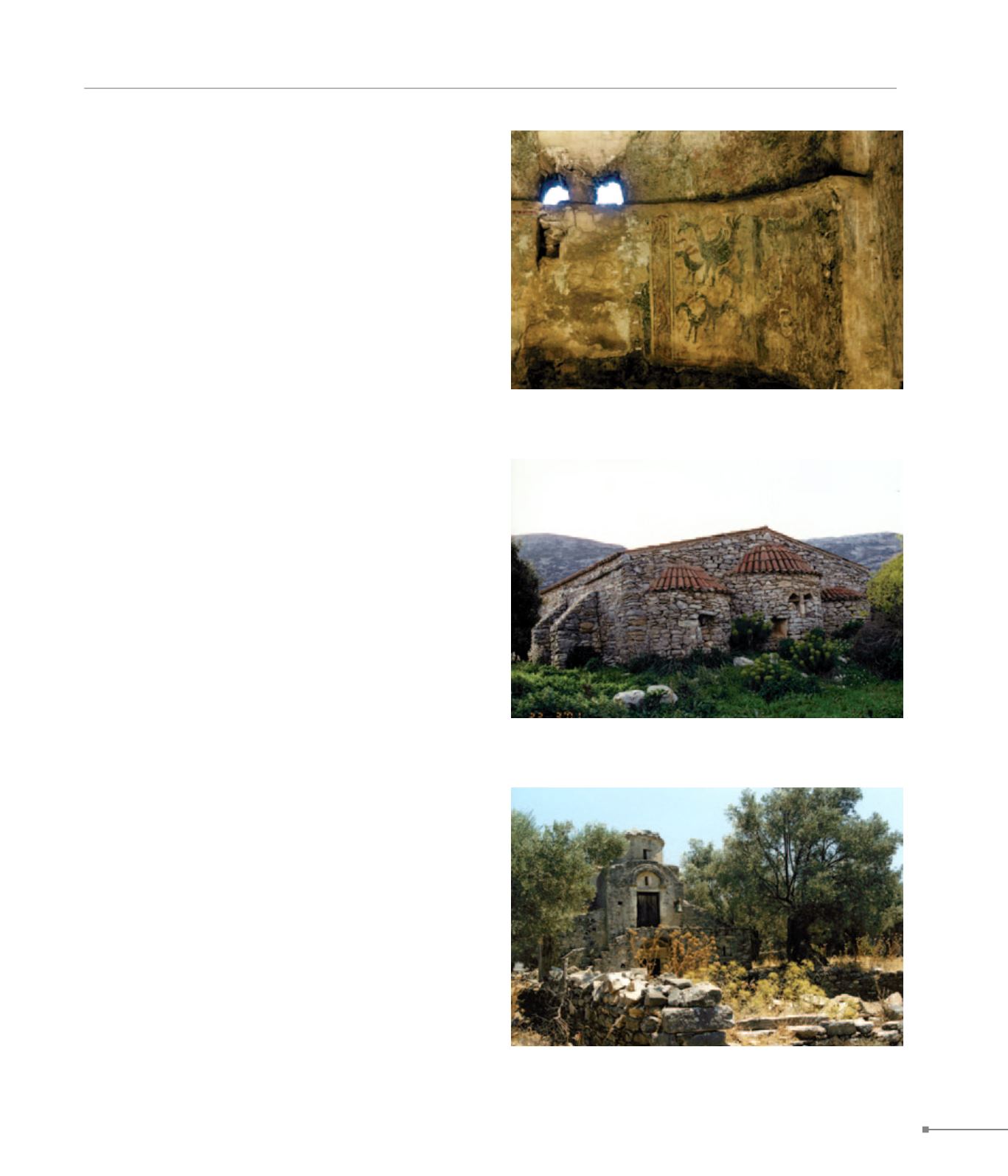
Naxos.
Naxos.
THE ISLANDS
369
589. Naxos, Apeiranthos, Aghia Kyriake, wall painting (Νάξος,
Απείρανθος, Αγία Κυριακή, τοιχογραφία)
589. Naxos, Kerami, Aghioi apostoloi at Metochi (Νάξος, Κεραμί, Άγιοι
Απόστολοι στο Μετόχι)
Naxos prospered and became administrative centre and met-
ropolitan see (1083) in the Mid-Byzantine period (9th-12th
c.). Of churches built in this period, the prevailing architec-
tural types are basilicas (Saint John Theologos at Afikli) (28),
cross-in-square churches (Aghioi Apostoloi at Kerami) (23)
and numerous aisleless, domed (Saint Nicholas at Sangri)
(17) or free cross plan churches (Panagia Damniotissa at Ka-
loksylos) (25), as well as barrel-vaulted, single-nave churches.
A significant number of Mid-Byzantine sculptures were re-
used as building material in later churches. Numerous marble
sculptures and architectural elements, such as those embed-
ded in the N wall of Panagia Damniotissa (25), date from the
late 10th and the 11th c. The frescoes in the church of Saint
George Diasorites (19) are among the most significant 11th c.
iconographical ensembles in the Aegean. It is a simple, four-
columned, cross-in-square church with dome and narthex,
its iconography programme displaying typical characteristics
of the 11th c. The Panagia Protothrone church at Chalki (19)
was restored in the Mid-Byzantine period and is currently a
transitional, cross-in-square church. On the later belfry an em-
bedded marble cornice records the date of renovation (1052)
and the names of Leo, bishop of Naxos, and Niketas, prot-
ospatharios and Naxos’ tourmarches. The layers of frescoes
in the Protothrone church represent a long period, from Icono-
clasm until the 13th c. The layer dating from 1052, when the
church was renovated, included the first-layer frescoes in the
dome (now removed) and the frescoes in the barrel vaults of
the crossarms. The wall-paintings in the NW funerary chapel
of Aghios Akindynos date from 1056.
The period of Latin suzerainty on Naxos began in 1204, when
Venetian Marco Sanudo founded the duchy of the Archipela-
go, with Naxos as the seat. Latin domination lasted until the
Ottoman occupation in 1566. Although Orthodox dioceses
were abolished, Orthodox artistic expression was never affect-
ed. Among 180 iconographical layers of fresco that have been
found in total, an impressively large number of works date from
the 13th c. and the first 15 years of the 14th c. Nearly all earlier
churches located in the areas of Sangri, Chalki and Philoti,
as well as in mountainous Apeiranthos, were again decorated
with frescoes in the 13th c. The newly built structures of that
period were usually small, barrel-vaulted churches. There are
nine iconographical ensembles precisely dated to the second
half of the 13th c. according to inscriptions: Saint George at
Apeiranthos (1252-4) (24), Saint Nicholas at Sangri (1269-70)
(17), Theotokos Dimou at Apeiranthos (1280-1) (24), Panagia
at Archatos (1285) (9), Saint George at Oskelos (1285-6) (7),
Saint George at Maratho (1285-6) (13), Saint George at Disto-
mo, Philoti (1286-7) (11), Panagia at Yiallou, Agiassos (1288-
9) (8) and Aghios Panteleimon at Pera Chalki (1291-2). Among
the most important churches that were frescoed in the same
period are Aghios Stephanos at Tsikalario (21), Saint John at
Kerami (23), Panagia Arion (18), Aghios Stephanos at Mar-
atho (13) and Saint George and Saint John at Siphones (29).
The wall-paintings preserved from the 14th c. are fewer and
comprise an extension of 13th c. art, seen in frescoes at the
church of Aghios Polycarpos at Distomo (1306-7) (11), Saint
589. Naxos, Apeiranthos, Saint John Theologos at Afikli (Νάξος,
Απείρανθος, Άγιος Ιωάννης ο Θεολόγος στ’ Αφικλή)


